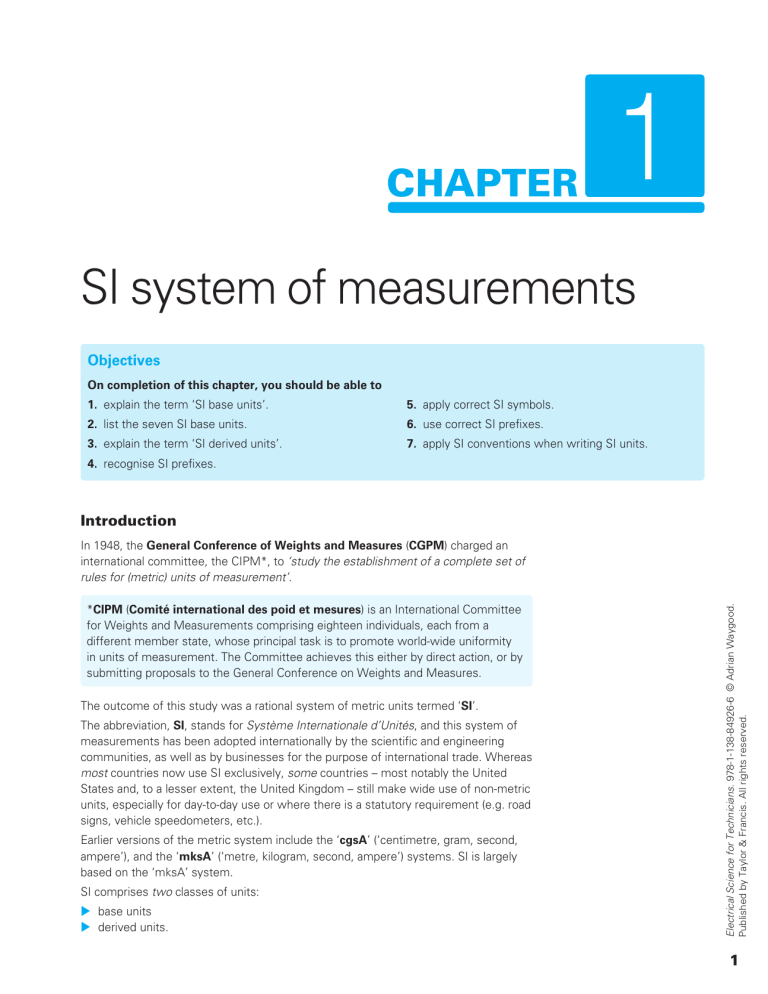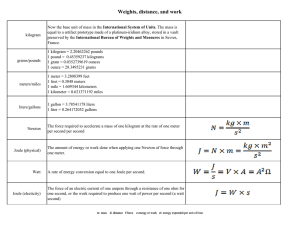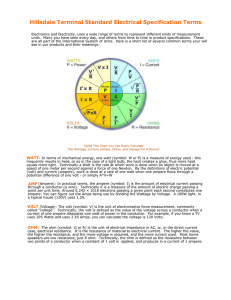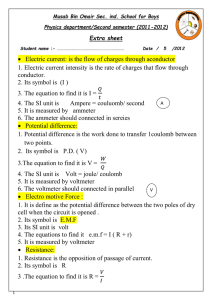
CHAPTER
1
SI system of measurements
Objectives
On completion of this chapter, you should be able to
1. explain the term ‘SI base units’.
5. apply correct SI symbols.
2. list the seven SI base units.
6. use correct SI prefixes.
3. explain the term ‘SI derived units’.
7. apply SI conventions when writing SI units.
4. recognise SI prefixes.
Introduction
*CIPM (Comité international des poid et mesures) is an International Committee
for Weights and Measurements comprising eighteen individuals, each from a
different member state, whose principal task is to promote world-wide uniformity
in units of measurement. The Committee achieves this either by direct action, or by
submitting proposals to the General Conference on Weights and Measures.
The outcome of this study was a rational system of metric units termed ‘SI’.
The abbreviation, SI, stands for Système Internationale d’Unités, and this system of
measurements has been adopted internationally by the scientific and engineering
communities, as well as by businesses for the purpose of international trade. Whereas
most countries now use SI exclusively, some countries – most notably the United
States and, to a lesser extent, the United Kingdom – still make wide use of non-metric
units, especially for day-to-day use or where there is a statutory requirement (e.g. road
signs, vehicle speedometers, etc.).
Earlier versions of the metric system include the ‘cgsA’ (‘centimetre, gram, second,
ampere’), and the ‘mksA’ (‘metre, kilogram, second, ampere’) systems. SI is largely
based on the ‘mksA’ system.
SI comprises two classes of units:
XXbase units
XXderived units.
Electrical Science for Technicians. 978-1-138-84926-6 © Adrian Waygood.
Published by Taylor & Francis. All rights reserved.
In 1948, the General Conference of Weights and Measures (CGPM) charged an
international committee, the CIPM*, to ‘study the establishment of a complete set of
rules for (metric) units of measurement’.
1
1 SI system of measurements
Base units
There are seven base units from which all other SI units are derived. These are:
Table 1.1
Quantity:
SI unit:
SI symbol:
length
metre
m
mass*
kilogram
kg
time
second
s
electric current
ampere
A
temperature
kelvin
K
luminous intensity
candela
cd
amount of substance
mole
mol
*The kilogram is a little confusing because it is the only base unit with a prefix
(kilo). It has been suggested that the name, ‘kilogram’ should be replaced as the
unit for mass, but this is likely to cause more confusion than necessary
Derived units
All those SI units that are not base units are called ‘Derived units’.
Derived units are formed by combining Base units – for example, the ‘watt’ is defined
as ‘the power resulting when one joule of energy is dissipated in one second’.
So the watt is defined in terms of the joule and the second. The second, of course, is
a Base unit, whereas the joule is a Derived unit defined in terms of the newton (also
a Derived unit) and the metre (a Base unit). The newton (see Appendix) is defined in
terms of the kilogram, the metre, and the second – which are all Base units.
So, by ‘deconstructing’ the watt, we find that it is ultimately derived from a
combination of each of the base units underlined, in the following chart – i.e. the
second, the kilogram, and the metre.
watt
joule
second
newton
kilogram
metre
metre
second
Figure 1.1
Most Derived units have been given special names in honour of famous physicists
or engineers whose research has contributed to our knowledge of the quantity
concerned – for example, as we have learnt, the Derived unit for power is the ‘watt’,
which is simply a special name given to a ‘joule per second’, and is named in honour
of the Scottish Engineer, James Watt (1736–1819).
The following table lists SI Derived units with special names that you will meet in this
text:
2
1 SI system of measurements
Table 1.2
Quantity:
Symbol: SI unit:
SI symbol:
capacitance
C
farad
F
capacitive reactance
XC
ohm
Ω
conductance
G
siemens
S
electric charge
Q
coulomb
C
force
F
newton
N
frequency
f
hertz
Hz
impedance
Z
ohm
Ω
inductance
L
henry
H
inductive reactance
XL
ohm
Ω
potential difference
E, U, V
volt
V
P
watt
W
Pa
power
pressure
p
pascal
resistance
R
ohm
magnetic flux
Φ
weber*
magnetic flux density
B
tesla
T
magnetomotive force
H
ampere**
A
mutual inductance
M
henry***
H
self inductance
L
henry
H
work, energy
W
joule
J
1
Ω
Wb
Notes: *The weber is pronounced ‘vay-ber’.
**Often spoken as ‘ampere turn’.
***The plural of ‘henry’ is ‘henrys’, not ‘henries’.
Non-SI metric units
Not all metric units are SI units, although many may be ‘used alongside’ SI units.
These include the following commonly used units:
Table 1.3
Quantity:
Unit:
Symbol:
energy
watt hour
W·h
mass
tonne
t*
volume
litre
L or l **
rotation
revolutions per second
r/s
temperature
degree Celsius***
ºC
time
minute (60 s); hour; day; year min, h, d, a
Notes: *The unit of mass, the tonne, is pronounced, or spoken, as
‘metric ton’.
**Since a lower-case ‘ell’ (l) can be confused with the number 1,
we shall use a capital ‘ell’ (L), in common with North American SI
practice.
***The division intervals are identical for the both the Celsius and
kelvin scales. However, 0ºC corresponds to 273.15 K, and 100ºC
corresponds to 373.15 K.
Multiples and sub-multiples
Frequently, we have to deal with very large, or very small, quantities. For example,
the resistance of insulation is measured in millions of ohms, while the resistance of a
conductor is measured in thousandths of an ohm.
3
1 SI system of measurements
To avoid having to express very large or very small values in this way, we use, instead,
multiples and submultiples. These are indicated by assigning a prefix to the SI unit.
The more common are listed below:
Table 1.4
Multiplication factor: Power of ten: Prefix:
Symbol:
1 000 000 000 000 ×
10
tera
T
1 000 000 000 ×
109
giga
G
1 000 000 ×
106
mega
M
1 000 ×
10
kilo
k
0.001 ×
10–3
milli
m
0.000 001 ×
10–6
micro
m
0.000 000 000 001 ×
10–12
pico
p
12
3
Examples
XX10 000 000 watts can be written as 10×106 W, or as 10 MW
XX33 000 volts can be written as 33×103 V, or as 33 kV
XX0.025 amperes can be written as 25×10–3 A, or as 25 mA etc.
*Note. The correct spelling for one-millionth of an ohm, is ‘microhm’, not
‘microohm’ or ‘micro-ohm’.
Note that SI prefixes employ the ‘Engineering System’ – i.e. powers of ten increase
or decrease by a factor of three. Accordingly, units such as ‘centimetre’ should not be
used when working in SI.
We cannot insert multiples or submultiples into equations. For example, we must
always convert microwatts, milliwatts, kilowatts, megawatts, etc., into watts
whenever we insert that quantity into an equation.
To do this:
Table 1.5
To convert…
into…
multiply by…
picowatts
watts
×10–12
microwatts
watts
×10–6
milliwatts
watts
×10–3
kilowatts
watts
×103
megawatts
watts
×106
gigawatts
watts
×109
terawatts
watts
×1012
Although, in the above example, we have used watts, this applies of course to any SI
unit.
SI conventions
SI specifies how its units of measurement should be written. These rules, or
conventions, apply to the units themselves, to their symbols, and to their associated
numerals.
You should be aware of the following conventions.
4
1 SI system of measurements
Rules for writing SI units
1 SI units and their symbols are never italicised:
e.g. ampere, not ampere
mV, not mV
2 When written in full, units are never capitalised.
e.g. watt, not Watt
ampere, not Ampere
3 SI symbols are written in lower case, unless they are named after someone, in
which case they are capitalised.
e.g. symbol for metre:
m
symbol for ampere: A (after André-Marie Ampère)
4 SI symbols are symbols, not abbreviations, so are not punctuated with full stops
(periods).
e.g. 230 V, not 230 V
13 A, not 13 A
5 There is no plural form of an SI symbol:
e.g. 500 kg, not 500 kgs
40 W, not 40 Ws
6 Numerals are always followed by the symbol for a unit:
e.g. 400 V, not 400 volts
10 kW, not 10 kilowatts
7 Written numbers are always followed by a written unit:
e.g. Twelve volts, not twelve V
8 A space is always placed between a number and the unit symbol:
e.g. 5000 W, not 5000W
275 kV, not 275kV
9 A hyphen may be used (optionally) between a number and the unit symbol, when
the combination is used as an adjective:
e.g. ‘A 66-kV power line.’ or ‘A 66 kV power line.’
‘A 13-A socket.’ or ‘A 13 A socket.’
10 Compound Derived unit symbols are separated by a point placed above the line:
e.g.SI unit for apparent power: V·A (volt ampere)
SI unit for resistivity: Ω·m (ohm metre)
11 No space is placed between an SI unit or symbol and its multiplier:
e.g.kilowatt, not kilo-watt or kilo watt
kW, not k-W or k W
Special case for ohms:
microhm, not microohm or micro-ohm
kilohm, not kiloohm or kilo-ohm
12 Spaces, not commas, are used as thousand-separators with large numbers:
e.g. 11 000 V, not 11,000 V
15 000.000 075, not 15,000.000075
The space is optional for four digits:
1500 mW or 1 500 mW
13 Square and cubic measurements are written as exponents:
e.g. m2 (square metres) not sq m
e.g. m3 (cubic metres) not cu m
1
Proposed new definitions for SI base units
A subcommittee of the International Committee for Weights and Measures (CIPM)
proposed revised definitions of the SI base units, for consideration at the 25th General
Conference of Weights and Measures (CGPM), which was held in November
5
1 SI system of measurements
2014. However, at that Conference, it was found that the necessary data were not
sufficiently ‘robust’ for the CGPM to adopt the revised definitions and a decision was
made to postpone any revisions until the next meeting, scheduled for 2018.
The proposal is that three of the Base units, the metre, second, and candela, will
essentially remain unchanged, except for the phrasing of their definitions, whereas the
remaining four will each undergo fundamental changes, as a result of allocating exact
values to five fundamental constants:
XXspeed of light
– based on the metre per second
XXPlanck’s constant – based on the joule second
XXelementary charge – based on the coulomb
XXBoltzmann constant – based on the joule per kelvin
XXAvogadro constant – based on the reciprocal of the mole.
Of particular interest to those of us who work in the electricity industry, is a proposed
major redefinition of the ampere. The proposed new definition removes its current
dependency on the kilogram and the metre and bases it, instead, on fixing the
numerical value of the elementary charge (the amount of charge on a single electron)
to a figure yet to be agreed.
If this change goes ahead, then it seems that the ampere may be defined in terms of
charge (but not the coulomb) and time.
Definitions of electrical SI units
ampere (symbol: A)
The ampere is defined as ‘the constant current that, if maintained in two straight
parallel conductors of infinite length and negligible cross-sectional area and placed
one metre apart in a vacuum, would produce between them a force equal to
2 × 10–7 newtons per unit length’.
coulomb (symbol: C)
The coulomb is defined as ‘the charge transported through any cross-section of a
conductor in one second by a constant current of one ampere’.
volt (symbol: V)
The volt is defined as ‘the potential-difference between two points such that the
energy used in conveying a charge of one coulomb from one point to the other is
one joule’.
joule (symbol: J)
The joule is defined as ‘the work done when the point of application of a force of
one newton is displaced one metre in the direction of that force’.
ohm (symbol: Ω)
The ohm is defined as ‘the electrical resistance between two points of a
conductor, such that when a constant potential-difference of one volt is applied
between those points, a current of one ampere results’.
newton (symbol: N)
The newton is defined as ‘the force which, when applied to a mass of one
kilogram, will give it an acceleration of one metre per second per second’.
watt (symbol: W)
The watt is defined as ‘the power resulting when one joule of energy is dissipated
in one second’.
farad (symbol: F)
The farad is defined ‘the capacitance of a capacitor, between the plates of
which there appears a difference in potential of one volt, when it is charged to
1 coulomb’.
6
1 SI system of measurements
weber* (symbol: Wb)
The weber is defined as ‘the magnetic flux that, linking a circuit of one turn,
produces a potential difference of one volt when it is reduced to zero at a uniform
rate in one second’.
(*pronounced ‘vay-ber’)
tesla (symbol: T)
The tesla is defined as ‘one weber of magnetic flux per square metre of circuit
area’.
henry (symbol: H)
The henry is defined as ‘the self- or mutual-inductance of a closed loop if a current
of one ampere gives rise to a magnetic flux of one weber’.
1
Conclusion
Now that we’ve completed this chapter, we need to examine its objectives listed at
its start. Placing a question mark at the end of each objective turns that objective into
a test item. If we can answer those test items, then we’ve met the objectives of this
chapter.
7




